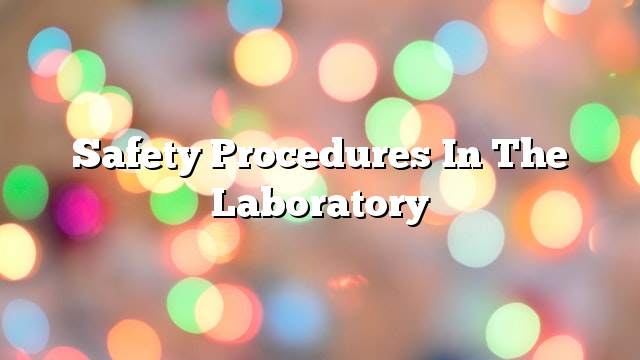Laboratory
It became the primary laboratory center for knowledge, new Ttaiwirmwad, and a center for studies of vaccines against various precipitant prevalent diseases in the world, and is a laboratory committee for research and amateur scientists. Safety is in the laboratory within the global rules and procedures for the foundations, which must be followed by everyone who works in this regard; the protection for himself, and for workers in the laboratory, as well as to protect the material and research that is where the work and developed within the laboratory.
Safety in laboratories
- The presence of an advanced management and control system in the laboratory.
- The nature of the places in which the laboratories and laboratories are located and the distance from the residential areas.
- The internal feeling of laboratory workers, their sense of responsibility for safety procedures and the preservation of their lives and the lives of their colleagues.
- The existence of safety and fire-fighting systems, and advanced sensors for volatile gases, which reduces the disaster caused by an error.
General safety measures by level
The protection of public health and the maintenance of security is a moral process of the first order, which requires the state to put the laws and enact the appropriate legislation to work on them in different laboratories and laboratories. The safety procedures in the laboratories vary according to the level of practice such as:
the eyes
- The most important means of prevention, the use of protective glasses to protect the eyes from the entry of chemicals or direct exposure to gases.
- When conducting chemical experiments or using radioactive materials, the entire body protector, including the head, neck and leather suit, should be used for this type of experiment.
- When dealing with laser, high lighting or high temperature use, wear appropriate glasses and made of custom materials.
- If you do not know what is in front of you, do not tamper with it at all, do not touch it or try to breathe it, or expose the eye directly to it.
- If chemicals enter the eye, consult your doctor as soon as possible, without trying to rub the eye with your hands.
Laboratory equipment
- A sophisticated protection system and sensors.
- The presence of sources of water and tools used to extinguish the fire and emergency exits.
- The existence of ventilation systems and special systems for the disposal of gases resulting from different experiments.
- Work to eliminate sewage waste properly.
Personal behavior of employees
- Use laboratory equipment within its intended purpose only.
- Work in the laboratory took a great deal of responsibility and not to be reckless with the employees during the experiments and applications.
- Children should not be admitted to laboratories and laboratories because they contain hazardous substances, chemicals and gases emitted.
- In the case of the introduction of student missions for the purpose of educational benefit should be kept under the supervision of trained workers.
- To avoid the inhalation of gases emitted from different experiments, or to enter chemicals into the body by accidentally drinking them or by means of wounds or substances. Acute use during the experiment.
Test cabinet
- When conducting hazardous and complex experiments, a ready-made cabinet, with special criteria for the materials used in these experiments, must be prepared and validated from time to time.
- Do not enter any part of the body at all to the test cabinet during the experiment, and make sure to wear the condom required for this experiment.
- Maintain the cleanliness of the test cabinet after completion of the experiment and remove the remaining materials properly.
- Lock the lock with a special key, and do not give the key to people who are not authorized for these tests.
Contact with skin chemicals
When testing, it is necessary to use different chemicals and tools, so check the following:
- There are no holes or holes in the gloves used.
- Be sure to wash the gloves before removing them from the hands; in order to remove all remaining chemicals and remaining on the gloves.
- Take care to replace gloves and use them for a certain period.
Clothes worn by workers
- When dealing with gears, engines or tools, make sure not to wear any type of garnet or ring to reduce the entry of these materials between the gears.
* Care to cover hair when dealing with incendiary materials.
* Do not wear sandals or open shoes when using chemicals to reduce the exposure of skin to these materials.
* Non-use of clothing made of synthetic fibers; for high flammability, and replace them with cotton clothes designed for the purpose of experiments.
